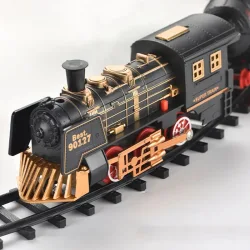Key Aspects of Model Trains
2024-05-17
Model trains are miniature replicas of real trains, including locomotives, rail cars, and tracks, often complemented by scaled-down buildings, landscapes, and accessories to create realistic environments. This hobby, known as model railroading or railway modeling, appeals to enthusiasts of all ages and offers a rich blend of history, engineering, and artistry.
Key Aspects of Model Trains
1. Scales and Gauges:
- Scale: Refers to the ratio of the model's size to the actual train. Common scales include:
- HO Scale (1:87): One of the most popular scales, offering a good balance between detail and space requirements.
- N Scale (1:160): Smaller than HO, allowing for more extensive layouts in limited spaces.
- O Scale (1:48): Larger models, often used in detailed and expansive setups.
- Z Scale (1:220): Among the smallest, ideal for compact layouts.
- Gauge: The distance between the rails on the track, which corresponds to the scale. Standard gauge measurements ensure compatibility of tracks and trains within each scale.
2. Components:
- Locomotives: Powered units that pull or push train cars. Types include steam, diesel, and electric models.
- Rolling Stock: Includes all train cars, such as passenger coaches, freight cars, and cabooses.
- Track: Made from materials like nickel-silver or brass, track systems include straight sections, curves, turnouts (switches), and crossings.
- Power Supply: Provides electricity to the tracks and locomotives, with modern systems using Digital Command Control (DCC) for advanced operation.
- Scenery and Structures: Includes buildings, trees, bridges, tunnels, and figures to create realistic landscapes.
3. Control Systems:
- Analog Control: Traditional method using variable voltage to control train speed and direction.
- Digital Command Control (DCC): Allows multiple trains to operate independently on the same track, with digital signals sent to decoders in each locomotive.
4. Layouts:
- Tabletop Layouts: Simple, often flat setups ideal for beginners.
- Modular Layouts: Sections that can be assembled and disassembled, allowing for flexibility and collaboration with other modelers.
- Realistic Layouts: Detailed and intricate, replicating specific geographical locations or time periods.
Popular Brands
- Hornby: Known for high-quality HO and OO scale models.
- Bachmann: Offers a wide range of scales and is known for its affordability and quality.
- Atlas: Renowned for its track systems and HO and N scale models.
- Kato: A leading brand for N scale models, praised for precision and detail.
- Lionel: Famous for O scale trains and a long history in the model train industry.
Building a Model Train Layout
1. Planning:
- Decide on the scale and theme (e.g., a specific era or location).
- Sketch a track plan considering space, track layout, and scenery.
- Determine the type of control system (analog or DCC).
2. Setting Up the Track:
- Lay the track according to the plan, ensuring smooth connections and proper alignment.
- Secure the track to the baseboard, typically made of plywood or foam board.
3. Wiring and Power:
- Install wiring for power supply, connecting to the tracks as per the chosen control system.
- Test the setup with a locomotive to ensure smooth operation and power distribution.
4. Creating Scenery:
- Build terrain using materials like foam, plaster, and papier.
- Add ground cover, trees, buildings, and other details to bring the layout to life.
5. Running the Trains:
- Operate the trains, making adjustments to track and scenery as needed.
- Maintain the trains and tracks, ensuring clean and debris-free operation.
Tips for Beginners
- Start Small: Begin with a simple layout to learn the basics before expanding.
- Join Clubs and Forums: Connect with other enthusiasts for advice, support, and inspiration.
- Research: Read books, magazines, and online resources to enhance your knowledge and skills.
- Patience and Precision: Take your time with construction and detailing for the best results.
In summary, model trains offer a fascinating and rewarding hobby that combines technical skills with creative expression. Whether you’re a novice or an experienced modeler, the world of model railroading provides endless opportunities for enjoyment and learning.



